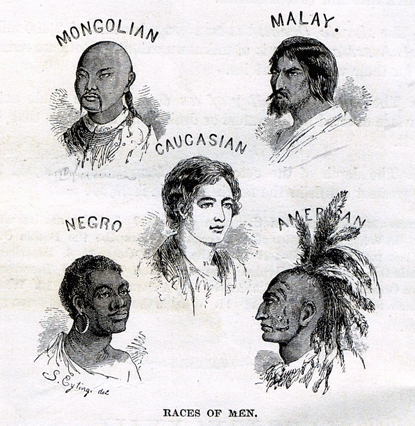
In a previous post I provided an account of the five different states of civilization from an 1879 geography text once owned by my great, great aunt. Apparently the author was enamored with the number “five,†since he also divided the human race into five distinct races. Let’s face it, race at the time was a visual matter of face (and hair) and notice in the image above who was in the middle. Here is the breakdown:
“1. The people inhabiting the different regions of the globe have been divided into five varieties, or races; namely, the Caucasian, or European; the Mongolian, or Asiatic; the Ethiopian, or African; the Malay; and the American or Indian.
2. The Caucasians are distinguished for their light complexion and straight hair. They inhabit nearly the whole of Europe, southwestern Asia, and a large part of America. The comprise the most enlightened and civilized nations of the world.
3. The Mongolians have a yellow complexion, high cheek-bones, and long dark coarse hair. They inhabit a large part of Asia, and the northern parts of Europe and America.
4. The Ethiopians comprise the different varieties of the negro, or black, race. They are found in central and southern Africa, and in the warm regions of other parts of the earth.
5. The Malays are distinguished for their brown complexion, flat face, and long coarse hair. They inhabit southeastern Asia and the islands in the vicinity.
6. The American Indians resemble somewhat the Mongolians. Their complexion is red, and they have a high cheek-bones and long dark hair.
7. They are found in the western parts of the United States and other parts of North America, and in South America.
8. The number of each race has been estimated as follows:
• Caucasian . . . . . . . . . . . 600,000,000
• Mongolian . . . . . . . . . . . 584,000,000
• African . . . . . . . . . . . . . 185,000,000
• Malay . . . . . . . . . . . . . . . .45,000,000
• American . . . . . . . . . . . . . 13,000,000
TOTAL . . . . . . . . . . . . . . 1,427,000,000″
Excerpt from: Colton’s Common School Geography (New York: Sheldon and Company, 1879), 16.
to be continued